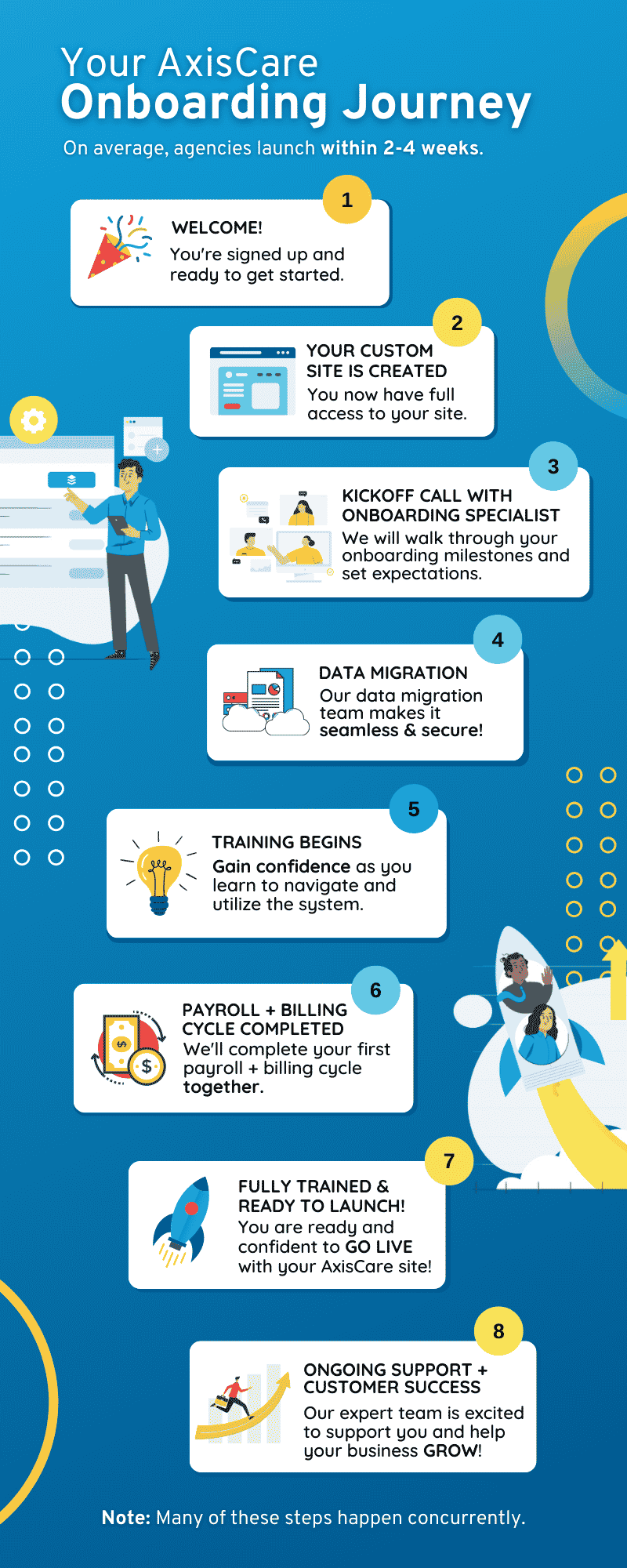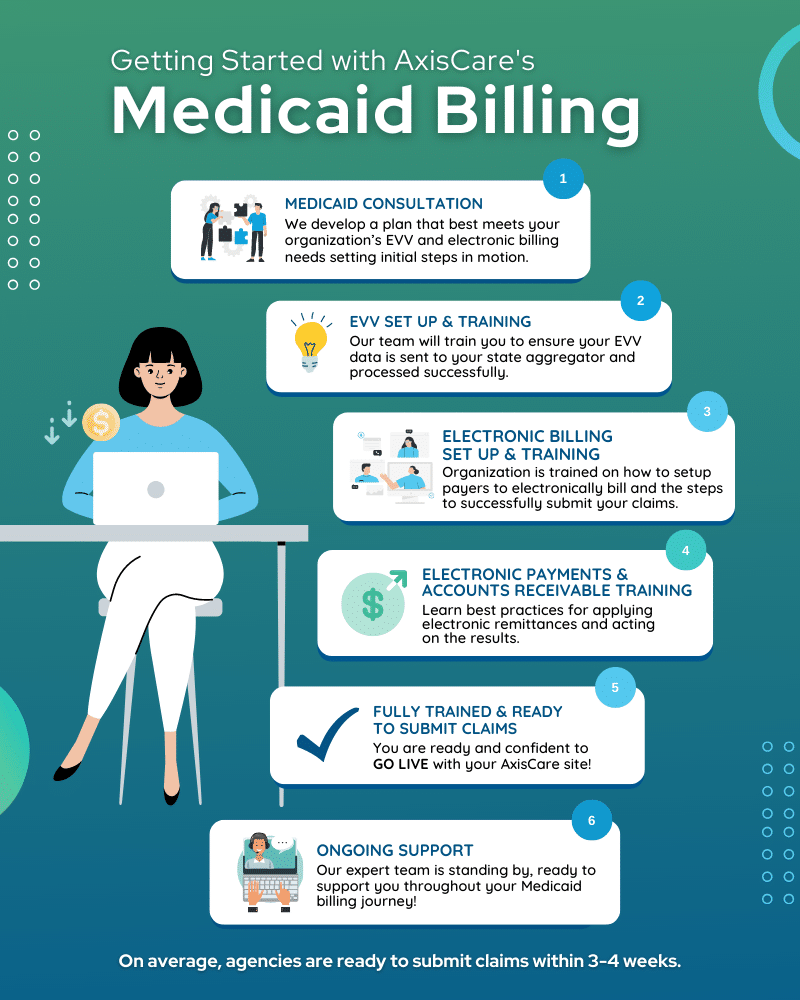Billing is a foundational element of every home care agency’s success. Maintaining healthy cash flows keeps the lights on, gets caregivers paid on time, and supports business growth in the long term. However, if there are holes in your billing process, your organization can quickly begin to take on water. Revenue will be lost if invoices are rejected, staff will be left frustrated by slow processing times, and compliance will be at risk if errors begin to accumulate.
If any of these home care billing challenges sound familiar, it’s time to build a better system. And while that might sound intimidating at the outset, the process can be made much simpler if you work with the right technology partner. This piece will guide you through the key steps necessary to streamline billing processes in a home care context, including practical implementation tips and the importance of this type of transformation.
1. Automate Key Billing Workflows
Billing workflows begin to break down when mistakes slip through the cracks. Whether it’s the wrong billing code or an unauthorized service, it’s not uncommon to provide the wrong information by accident when so much data entry is required. Each invoice has multiple fields that need to be completed, and each one presents an opportunity for an error or omission.
Automation can solve the majority of these challenges by eliminating the need for manual data entry. By automatically populating invoices with verified data from care records it dramatically reduces typos, mismatched codes, and missing fields. Over time, these small wins add up, saving hours of administrative work and reducing the incidence of payment delays or rejections.
2. Centralize Billing & Documentation Systems
Disconnected tools and trackers can create major bottlenecks for home care agencies. When data is spread across multiple platforms or siloed in individual spreadsheets, staff spend extra time tracking down information and manually re-entering data in multiple places. Every time information is re-typed, it introduces the opportunity for an error to crop up, all while slowing down billing, payroll, and reporting processes.
A unified software improves home care by pulling information straight from agencies’ patient records and caregiver notes, then dropping it straight into the associated invoices. The result is a seamless payroll processing system where everyone works from the same reliable data source. This is helpful not only for invoice accuracy, but also audit readiness: tracing every billed item back to an approved client service record is immutable proof of compliance.
3. Improve Coding Accuracy & Claim Validation
Each denied claim creates extra work, whether it’s a resubmission, correction, or follow-up – so preventing errors upfront is one of the most effective ways to streamline billing workflows. For example, including the proper International Classification of Diseases (ICD) and Healthcare Common Procedure Coding System (HCPCS) coding is a must to ensure services are documented properly and reimbursed at the appropriate rate.
Understanding and adhering to payer-specific rules also helps prevent rejections that are caused by policy mismatches. Pre-submission validation adds yet another layer of protection by automatically checking for missing fields, invalid codes, or other errors, flagging any inconsistencies that need correcting before claims are sent off.
4. Monitor & Manage Claim Denials Proactively
Even the most airtight revenue cycle management systems can let errors slip through from time to time. But with the right systems in place, you can turn lemons into lemonade: tracking and categorizing denials provides insight into recurring problems, helping you identify weak spots within your workflows and tackle problems at the source.
There are a number of reasons why a claim might get denied, from incorrect or missing codes to eligibility issues or incomplete documentation. For example, a claim might be denied if a patient’s care plan doesn’t line up with a billed service, or if a required authorization wasn’t obtained before a visit from a specialized caregiver. Proactively checking for these issues through pre-submission validation and regular audits is a direct path to decreasing resubmissions, getting claims accepted faster, and maintaining more predictable cash flows.
5. Simplify Home Care Invoices for Clients & Families
Clear, accurate invoices are a pillar of trust – especially among older populations that may not be as able to interpret complex information. When statements are easy to read and transparent about services rendered, clients will feel confident that they’re being charged fairly. And if they don’t feel the need to scrutinize line by line, they’re also more likely to settle up faster.
Adding automation into the mix can make the patient collections process even smoother. Invoice reminders help clients stay on top of their due dates, and flexible payment options like online portals make it easy to receive payments promptly.
6. Track Key Billing Metrics for Continuous Improvement
Once a billing system is put in place, tracking key performance indicators (KPIs) like denial rates, days in accounts receivable (A/R), and clean claim rates – which measures how many claims are accepted upon first submission – gives agencies valuable insights into how well its systems are running.
If denials are common, there may be issues with improper coding or documentation. A/R slowdowns can point to delays with claim submissions or payer follow-ups, whereas a strong clean claim rate indicates that everything is working as it should. Using dashboards to keep an eye on these KPIs is a great way for agencies to catch issues as soon as they crop up, and on a longer timeline, to identify which training, automation, or policy adjustments can deliver the most value.
7. Use Specialized Home Care Billing Services (When Needed)
Keeping up with all of these responsibilities is a tall order for any agency, but especially smaller organizations with fewer resources to go around. Home care billing services can help them get more done with less, giving finance teams the tools to process invoices faster and more accurately than they could using manual inputs.
Why should a human employee spend time reviewing every bill when software can verify them within seconds? Digital transformation is often the gateway to longer-term growth, returning valuable time to busy employees who can then focus on value-added tasks instead of tedious admin.
8. Train Staff Regularly & Standardize Processes
An agency’s billing system is only as powerful as the team behind it. Every employee involved in the financial cycle should be up-to-date on coding protocols, payer requirements, and internal policies to reduce errors and support the agency’s overall health.
Standardized documentation is one of the most important items in their toolkit: when information is recorded in the same format organization-wide, it reduces confusion, simplifies audits, and creates a reliable foundation for claim submission.
9. Build Compliance Into Every Step
Programs like Medicaid come with strict billing and documentation rules, while Electronic Visit Verification (EVV) systems ensure that services billed were actually delivered. If agencies fail to meet regulatory standards, they can be subject to hefty fines and penalties, all of which directly impact their bottom line.
Treating compliance as an essential part of the billing process is the best way to ensure every claim is backed by verified visit data and accurate documentation. With all of these ducks in a row, agencies can bill confidently and improve ROI as penalties become less and less frequent.
10. Plan an Implementation Roadmap for Change
Before you take the leap into the world of streamlined billing, lay out a phased roadmap for rolling out your new strategy. Determine which parts of your current system you’d like to keep and which ones can be replaced by a newer, more efficient workflow. Then, vet a couple of software providers to understand what they bring to the table, from in-platform features to human-centric customer support.
When it’s time to roll out, consider running a pilot launch to smooth out any initial snags before deploying at scale. Every step of the way, keep change management and proactive communication at the heart of your approach, keeping teams informed about why the changes matter and providing hands-on training. Without their buy-in, your digital transformation won’t succeed – so encourage adoption through education and celebrating early wins.
Streamline Your Billing Process With AxisCare
Streamlining billing means efficiency, accuracy, and revenue stability. If you’re ready to cut down on administrative time, rejected bills, and non-compliance penalties, request a free demo with our team.









